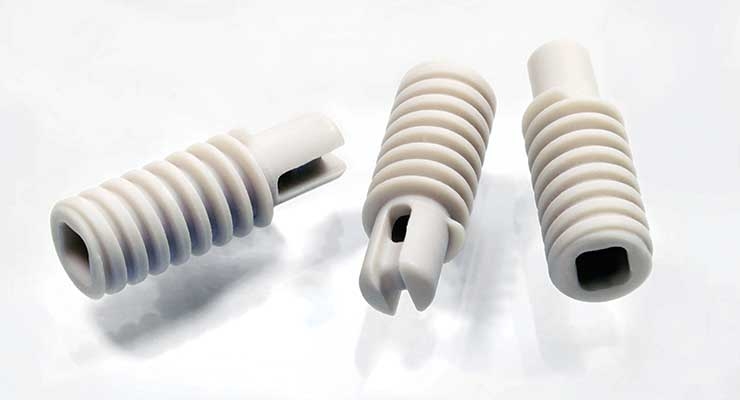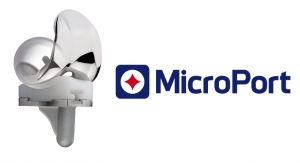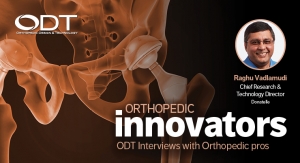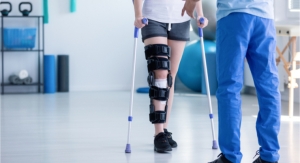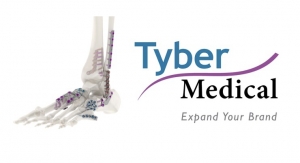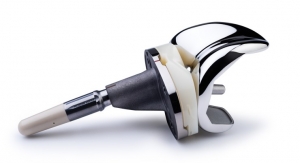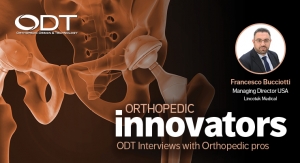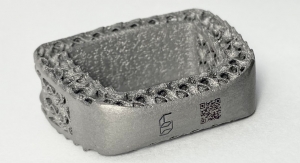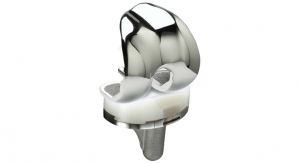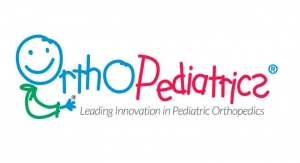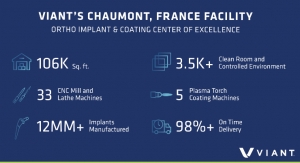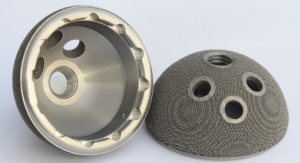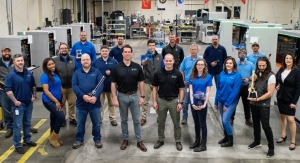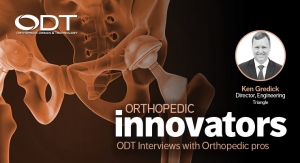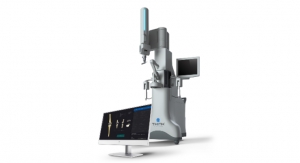Sam Brusco, Associate Editor03.22.17
Graphene—the two-dimensional allotrope of carbon taking the form of a two-dimensional, atomic scale hexagonal lattice in which one atom forms each vertex—was discovered by University of Manchester scientists in 2004. Or, rather, one should say it was rediscovered, as it had unintentionally been produced in small amounts with pencils or other graphite uses for centuries. The University of Manchester researchers were the first to create and document graphene flakes one atom thick, and because of this, graphene was awarded its 2D status. Two hundred times stronger than steel, immensely light, and an excellent conductor, it is being hailed as the next “wonder material” for biomedical applications. And once manufacturers can discover a method to produce it beyond haphazard flakes, graphene could usher in new classes of orthopedic technologies.
For example, in September 2016, the Rice University lab of materials scientist Pulickel Ajayan, in concert with colleagues in Texas, Brazil, and India, were able to weld flakes of graphene oxide in porous solids using spark plasma sintering. The researchers discovered the 3D graphene material compared favorably with titanium—a standard bone-replacement material—in both mechanical properties and biocompatibility.
“We started thinking about this for bone implants because graphene is one of the most intriguing materials with many possibilities and it’s generally biocompatible,” commented Rice postdoctoral research associate Chandra Sekhar Tiwary, co-lead author of the paper on the discovery in Advanced Materials, with Dibyendu Chakravarty of the International Advanced Research Center for Powder Metallurgy and New Materials in Hyderabad, India. “Four things are important: its mechanical properties, density, porosity, and biocompatibility.”
The researchers are confident this method will facilitate forming highly complex shapes out of graphene in minutes using graphite molds. They later discovered the sintering process is capable of reducing graphene oxide flakes into pure bilayer graphene, making it much more stable than graphene monolayers.
“This example demonstrates the possible use of unconventional materials in conventional technologies,” Ajayan said. “But these transitions can only be made if materials such as 2D graphene layers can be scalably made into 3D solids with appropriate density and strength.”
Rice University lab was back to its orthopedic graphene hijinks later in September, this time under the tutelage of chemist James Tour. Tour’s lab has spent over a decade experimenting with graphene nanoribbons, resulting in a material dubbed “Texas PEG” that could knit damaged or even severed spinal cords. Texas PEG is a combination of graphene nanoribbons customized for medical use with polyethylene glycol (PEG, hence the name), a biocompatible polymer gel used in surgeries and pharmaceutical products. The PEG chains functionalize the edges of the biocompatible nanoribbons, and when further mixed with PEG, form an electrically active network that could help reconnect the severed ends of a spinal cord.
Tour said only about 1 percent of the Texas PEG material consists of nanoribbons, but that’s more than enough to form a conductive scaffold to reconnect the cord. The material was successful in restoring function in a procedure performed at Konkuk University in South Korea. Motor and sensory signals bridged the gap via Texas PEG a day after complete spinal transection, and almost perfect motor control recovery was gained in two weeks.
Material Witnesses
Graphene is certainly a trendy material to work with in the research stages, but has a long way to go before becoming a viable orthopedic material. The market dictates that orthopedic devices are made to last a long time and resist wear, and current studies on graphene are inconclusive in this regard. Although graphene has demonstrated favorable biocompatibility—which is of the utmost importance for musculoskeletal implants—an innovative material must undergo a lengthy regulatory and trialing process before consideration in a Class III orthopedic device.
Beyond the research stages, however, both implantable orthopedic devices and surgical instruments are seeing a migration away from traditional metal components. Metal has typically been the material of choice for a number of orthopedic devices, but they have become a source of apprehension in recent years. Metal-on-metal implants have been found to release tiny fragments of metal into surrounding tissue, which can lead to infection—sometimes fatally. Metal fracture fixation pins that must be surgically inserted and removed require revision surgeries. Some metal implants prohibit patients from undergoing magnetic resonance imaging testing.
“From a historical perspective, and today, metals such as titanium lend themselves to superb strength and stability, but there are also challenges with the stiffness metals present. It can be a case of too much,” commented Bing Carbone, president of Modern Plastics, a Shelton, Conn.-based distributor of engineering- and medical-grade plastics. “There is an interesting phenomenon called ‘stress shielding’ often associated with titanium implants. What basically happens is that these implants will soften the bone to which they are attached. Without getting into the whole science of this, let’s just say that when stiff metals take over the function of the bone, well, it simply loses strength. The solution is to use materials that have an elastic modulus much closer to that of bone.”
Manufacturing orthopedic surgery instrumentation and implants out of high-performance plastics can offer a number of benefits, including the elastic modulus mimicking bone that Carbone is referring to. The injection molding tooling process is fundamentally less expensive than machining due to the processing itself—plastic parts can be molded in seconds, whereas machining a metal component can take minutes. Furthermore, more complex geometries for orthopedic implants can be designed with plastics, plastic instruments can be color-coded to facilitate quick identification in the operating room, and some can even be made transparent so the surgeon can see through the component during a procedure. Plastic orthopedic instruments also open the door to different sterilization tactics, which can be limited using metal.
“We have seen a trend of moving from metal to plastic in a number of surgical devices,” noted Lauren Zetts, market segment manager of medical and consumer products at Pittsburgh, Pa.-based Covestro LLC, a manufacturer of high-tech polymers. “Often, the metal devices are costly and need to be sterilized after each use, which can be a labor-intensive and complicated process. When a plastic such as our Makrolon polycarbonate is used, there are a variety of different sterilization methods (gamma, e-beam, or EtO) that can be used to provide a sterilized product ready for use. Plastic surgical devices provide a certain convenience to the hospital or surgical center by removing complexity and the potential risks of sterilizing after each use.”
Polymers can also potentially lower costs and yield more flexible designs for orthopedic implants. The orthopedic industry sits in the uncommon position where applications previously relegated to metals can be supplanted with plastics. Though usually not quite as strong as their metal counterparts, plastics have been designed to imitate some of metal’s physical properties, such as impact strength and ductility. Further, plastics lack many of metal’s aforementioned flaws that can’t simply be designed away.
“Over recent years, there has been a gradual shift from traditional metallic-based implants to synthetic polymer and biologically derived materials,” observed Niall Rooney, director of business development at Proxy Biomedical, a Galway, Ireland-based outsource manufacturer of medical implants. “While metal-based implants offer maximum strength, their stiffness relative to human bone can lead to post-operative complications. Non-resorbable synthetic polymers can instead exhibit mechanical performance characteristics which are more in line with those of native tissue, in terms of strength and stiffness.”
Orthopedic polymers also offer the potential to be enhanced with additives to facilitate osteogenesis and/or osteointegration.
“The trends in orthopedics have been for more polymeric biomaterials and the addition of functional ingredients to polymeric biomaterials,” stated Tony Listro, vice president of technology for Putnam, Conn.-based Foster Corporation, a provider of custom biomedical polymer compounding services. “Functional ingredients are ingredients added to the polymer in order to enhance performance in the end use application. An example of this is the addition of an additive to enhance bone growth or tissue integration in the device.”
Ultra-high molecular weight polyethylene (UHMWPE), a subset of the thermoplastic polyethylene, is also finding success in orthopedic applications. Thanks to its very low moisture absorption rate, low coefficient of friction, self-lubricating properties, and high resistance to abrasion, it has a proven clinical history as a biomaterial for hip, knee, and spine implants. Further, since 2007, manufacturers have begun incorporating antioxidants into UHMWPE for hip and knee arthroplasty bearing surfaces to help quash free radicals introduced during the irradiation process.
“Strength, wear reduction, and accelerated healing remain primary drivers for many biomaterials,” said Tim Shannon, vice president and general manager, global orthopedics at Exton, Pa.-based designer, manufacturer, and licenser of advanced biomaterials and devices, DSM Biomedical. “A good example is in UHMWPE, where higher strength, smaller profiles, expanded colors, and radiopaque features are opening the door to entirely new applications.”
“Non-resorbable synthetic polymers such as PEEK and UHMWPE are now established as key performance materials for long term support,” said Rooney. “Meanwhile, synthetic resorbable polymers containing polylactic acid, and polyglycolic acid, and polycaprolactone provide desirable properties in terms of short term strength with gradual mass loss, as a result, facilitate improved tissue regeneration.”
Biomaterials that aid and abet tissue regeneration are hot-ticket items in orthopedic implant manufacturing. These materials are by no means new—since the 1980s, a number of biomaterials have demonstrated the ability to induce formation of bone when implanted in a process called osteoinduction. Osteoinductive biomaterials typically include anything from natural or synthetic bone grafts (such as DePuy Synthes’ recently launched ViviGen Cellular Bone Matrix) to hydroxyapatite, a calcium phosphate similar to human bone tissue that can serve as a scaffold for new bone growth or to replace lost bone.
“On the orthobiologic front, there is an increased interest in next-generation osteoinductive capabilities, leading to an increase in demand for more efficient scaffolds with both improved handling and remodeling potential,” offered Shannon. “In addition, the potential benefits of cell concentration is growing as newer data emerges, distinguishing the effectiveness of the devices and the procedures.” (For more information on orthobiologic materials, read managing editor Michael Barbella’s article on the subject, entitled “Nature’s Way,” in the January/February edition of ODT.)
That’s a fairly lengthy list of alternative polymers and biomaterials that are making their way into musculoskeletal implants. However, before orthopedic OEMs completely rule out manufacturing devices made from metal, their benefits should be noted, and some misconceptions made clear.
“As a direct result of the issues that orthopedic device OEMs have faced with the metal-on-metal implants over the past few years, we have seen a noticeable decline in the demand for high carbon cobalt-chrome-moly material (CCM Plus: ASTM F1537 Alloy 2),” explained Steve Smith, president of Dayton, Ohio-based Edge International, a distributor of medical grade raw materials. “However, despite the negative comments in the media about cobalt and chromium as a result of the metal-on-metal issues, we are not seeing any adverse effect on the use of cobalt-chrome-moly in general. Titanium (primarily Ti 6Al-4V ELI) and Cobalt-Chrome-Moly are the most suitable materials currently available for implantable devices, due to their biocompatibility, corrosion resistance, and wear resistance. Cast cobalt-chrome-moly is the principal material for replacement knees, and wrought cobalt-chrome-moly and titanium are used in the production of replacement hip systems and extremities. Titanium is also the material of choice for trauma applications.”
Taking a Glimpse at PEEK
The medical polymer polyetheretherketone (colloquially referred to as PEEK) is by no means a “new” material for orthopedic implants—it has been used experimentally in medical devices since the 1980s. After a series of clinical studies in the 1990s, PEEK gained widespread clinical acceptance. The first implantable unfilled PEEK polymer (PEEK-OPTIMA) was engineered in 1990, and since then the material has been used in many orthopedic applications.
PEEK attained celebrity status for orthopedic devices because the family of polymers it belongs to (polyaryletherketones or PAEKs) are inherently strong, inert, and biocompatible. Because of this inertness, PEEK biomaterials become an attractive option to develop bioactive materials. It has had perhaps the greatest clinical impact on spine implant design, and is now widely accepted as a radiolucent alternative to metallic biomaterials in the spine community. And although PEEK is well over 30 years old, it turns out that an old material can learn new tricks.
“Amazingly, but not surprisingly, it is PEEK once again that is finding its way into applications that were improbable a few years ago, based on price points of the product along with several other factors,” mused Carbone. “PEEK is really the product to keep an eye on this year, relative to its increased use in existing and new orthopedic applications.”
“The most commonly requested material for spinal implants is PEEK. PEEK is selected for permanent implant applications such as a spinal implant, because it is a polymer that has excellent biocompatibility, has a very high modulus, and it does not deform under load over time,” observed Listro.
That’s not to say manufacturing orthopedic implants with PEEK doesn’t come with challenges, however. After almost three decades of research, manufacturers still encounter cost-related issues in molding PEEK. As opposed to the formed rods and sheets typically made using machining methods, molding PEEK—which would produce the more homogeneous product desired for orthopedic implants—can be quite expensive.
“PEEK is a very high temperature polymer and requires special process equipment to mix it with functional ingredients or convert it into a finished shape,” continued Listro. “It adheres very well to metal when molten, making it very difficult to clean after processing. These factors make it very expensive to process PEEK.”
While PEEK’s popularity is certainly warranted in some cases—particularly in spinal implants—jumping on PEEK’s bandwagon isn’t always necessary. Many applications don’t require PEEK’s chemical resistance and crystalline properties, making it overqualified for many applications. On the flip side, many orthopedic OEMs dead-set on making devices from PEEK are realizing that it can actually be underqualified for a number of clinical applications.
“Surgeons are looking into alternate materials and new structural designs across all of orthopedics,” explained Shannon. “Looking at spine, we see the combination of existing materials such as titanium coatings and PEEK. Traditional PEEK spacers, though still very popular, have not been providing the initial stability that is clinically needed, hence the advent of more expensive secured spacers and the additional process of coating PEEK with titanium. Companies, universities, and physicians are looking for better fusion solutions, and those solutions will most likely be based on the commercialization of new biomedical materials.”
Materials of the Future
It’s difficult not to buy into the graphene hype when research in some new and exciting medical application is revealed, but it still has a long journey into a viable option for musculoskeletal devices and implants. Continued experimentation will reveal further knowledge of graphene’s material properties, then it will undergo clinical trialing and regulatory approvals—and even then, there may not be a reliable enough method to manufacture it on a commercial scale.
The orthopedic device market, however, offers a promising venue to develop or tune medical polymers for additive manufacturing. Recent innovations in 3D printing technology have proven 3D printers can handle plastics, metals, and even biological materials. Many materials experts believe polymers for additive manufacturing of orthopedic technologies will make great strides in the next few years.
“I believe we will continue to see existing and new polymers developed for 3D printing of orthopedic implants,” predicted Carbone. Smith shared the sentiment, saying he expects “continued growth in the use of powder alloys for 3D-printed parts, as the equipment becomes more cost-effective, thereby creating a greater opportunity for the design of custom and semi-custom parts.”
Drug-eluting devices have been commercially available for some time now, but these devices are in fairly infant stages in the orthopedic market. However, some believe them to be a promising growth area.
“Some of the most promising future applications include combination medical devices where a drug is incorporated or melt blended in a polymer and then shaped into an orthopedic device,” predicted Listro. “Examples of this are those cases where a pain relief drug or an antibiotic is incorporated into the polymer so the orthopedic device delivers the drug locally to promote healing.”
Listro also emphasized the continued innovation in orthopedic polymers, saying “I anticipate the use of polymers to be the fastest-growing class of biomaterials. The reasons are that these materials can be blended with bioactive ingredients readily. Another reason for this trend is because polymers can be directly shaped to form the finished part using tried and true processes such as injection molding, eliminating the need for machining parts. Fewer processing steps when making orthopedic devices will lead to better quality.”
Resorbable materials (also called absorbable, bioabsorbable, or biodegradable), also offer a great deal of potential in orthopedics—imagine a bone screw that gradually fades away after doing its work, reducing the risk of postoperative complications. Resorbable technologies have existed for some time, but last year’s U.S. Food and Drug Administration approval of Abbott’s resorbable stent thrust these back into the mainstream. Resorbable orthopedic materials are expected to follow suit and proliferate.
“While new technologies now exist to enable the use of resorbable polymers for more load bearing applications, regulatory requirements, resulting product development timelines, as well as market inertia, dictate a gradual commercial adoption,” prognosticated Rooney. “This trend is likely to continue for many years. Nevertheless, the technological and material advancements to produce higher strength resorbable materials for implants and sutures will ensure greater efficacy of existing resorbable devices, and promote the ongoing transition from traditional non-resorbable offerings.”
Carbone also urged OEMs to remain aware of stirrings in regulatory procedure that could affect their projects.
“There are some changes coming up this year relative to medical-grade Acetal resin formulations which will cause OEMs to rewrite their specifications to re-test and/or re-certify the product again,” he cautioned. He also expressed an optimistic outlook on the market, saying “We expect overall growth in the industry, coming off a very significant growth period in 2016.”
For example, in September 2016, the Rice University lab of materials scientist Pulickel Ajayan, in concert with colleagues in Texas, Brazil, and India, were able to weld flakes of graphene oxide in porous solids using spark plasma sintering. The researchers discovered the 3D graphene material compared favorably with titanium—a standard bone-replacement material—in both mechanical properties and biocompatibility.
“We started thinking about this for bone implants because graphene is one of the most intriguing materials with many possibilities and it’s generally biocompatible,” commented Rice postdoctoral research associate Chandra Sekhar Tiwary, co-lead author of the paper on the discovery in Advanced Materials, with Dibyendu Chakravarty of the International Advanced Research Center for Powder Metallurgy and New Materials in Hyderabad, India. “Four things are important: its mechanical properties, density, porosity, and biocompatibility.”
The researchers are confident this method will facilitate forming highly complex shapes out of graphene in minutes using graphite molds. They later discovered the sintering process is capable of reducing graphene oxide flakes into pure bilayer graphene, making it much more stable than graphene monolayers.
“This example demonstrates the possible use of unconventional materials in conventional technologies,” Ajayan said. “But these transitions can only be made if materials such as 2D graphene layers can be scalably made into 3D solids with appropriate density and strength.”
Rice University lab was back to its orthopedic graphene hijinks later in September, this time under the tutelage of chemist James Tour. Tour’s lab has spent over a decade experimenting with graphene nanoribbons, resulting in a material dubbed “Texas PEG” that could knit damaged or even severed spinal cords. Texas PEG is a combination of graphene nanoribbons customized for medical use with polyethylene glycol (PEG, hence the name), a biocompatible polymer gel used in surgeries and pharmaceutical products. The PEG chains functionalize the edges of the biocompatible nanoribbons, and when further mixed with PEG, form an electrically active network that could help reconnect the severed ends of a spinal cord.
Tour said only about 1 percent of the Texas PEG material consists of nanoribbons, but that’s more than enough to form a conductive scaffold to reconnect the cord. The material was successful in restoring function in a procedure performed at Konkuk University in South Korea. Motor and sensory signals bridged the gap via Texas PEG a day after complete spinal transection, and almost perfect motor control recovery was gained in two weeks.
Material Witnesses
Graphene is certainly a trendy material to work with in the research stages, but has a long way to go before becoming a viable orthopedic material. The market dictates that orthopedic devices are made to last a long time and resist wear, and current studies on graphene are inconclusive in this regard. Although graphene has demonstrated favorable biocompatibility—which is of the utmost importance for musculoskeletal implants—an innovative material must undergo a lengthy regulatory and trialing process before consideration in a Class III orthopedic device.
Beyond the research stages, however, both implantable orthopedic devices and surgical instruments are seeing a migration away from traditional metal components. Metal has typically been the material of choice for a number of orthopedic devices, but they have become a source of apprehension in recent years. Metal-on-metal implants have been found to release tiny fragments of metal into surrounding tissue, which can lead to infection—sometimes fatally. Metal fracture fixation pins that must be surgically inserted and removed require revision surgeries. Some metal implants prohibit patients from undergoing magnetic resonance imaging testing.
“From a historical perspective, and today, metals such as titanium lend themselves to superb strength and stability, but there are also challenges with the stiffness metals present. It can be a case of too much,” commented Bing Carbone, president of Modern Plastics, a Shelton, Conn.-based distributor of engineering- and medical-grade plastics. “There is an interesting phenomenon called ‘stress shielding’ often associated with titanium implants. What basically happens is that these implants will soften the bone to which they are attached. Without getting into the whole science of this, let’s just say that when stiff metals take over the function of the bone, well, it simply loses strength. The solution is to use materials that have an elastic modulus much closer to that of bone.”
Manufacturing orthopedic surgery instrumentation and implants out of high-performance plastics can offer a number of benefits, including the elastic modulus mimicking bone that Carbone is referring to. The injection molding tooling process is fundamentally less expensive than machining due to the processing itself—plastic parts can be molded in seconds, whereas machining a metal component can take minutes. Furthermore, more complex geometries for orthopedic implants can be designed with plastics, plastic instruments can be color-coded to facilitate quick identification in the operating room, and some can even be made transparent so the surgeon can see through the component during a procedure. Plastic orthopedic instruments also open the door to different sterilization tactics, which can be limited using metal.
“We have seen a trend of moving from metal to plastic in a number of surgical devices,” noted Lauren Zetts, market segment manager of medical and consumer products at Pittsburgh, Pa.-based Covestro LLC, a manufacturer of high-tech polymers. “Often, the metal devices are costly and need to be sterilized after each use, which can be a labor-intensive and complicated process. When a plastic such as our Makrolon polycarbonate is used, there are a variety of different sterilization methods (gamma, e-beam, or EtO) that can be used to provide a sterilized product ready for use. Plastic surgical devices provide a certain convenience to the hospital or surgical center by removing complexity and the potential risks of sterilizing after each use.”
Polymers can also potentially lower costs and yield more flexible designs for orthopedic implants. The orthopedic industry sits in the uncommon position where applications previously relegated to metals can be supplanted with plastics. Though usually not quite as strong as their metal counterparts, plastics have been designed to imitate some of metal’s physical properties, such as impact strength and ductility. Further, plastics lack many of metal’s aforementioned flaws that can’t simply be designed away.
“Over recent years, there has been a gradual shift from traditional metallic-based implants to synthetic polymer and biologically derived materials,” observed Niall Rooney, director of business development at Proxy Biomedical, a Galway, Ireland-based outsource manufacturer of medical implants. “While metal-based implants offer maximum strength, their stiffness relative to human bone can lead to post-operative complications. Non-resorbable synthetic polymers can instead exhibit mechanical performance characteristics which are more in line with those of native tissue, in terms of strength and stiffness.”
Orthopedic polymers also offer the potential to be enhanced with additives to facilitate osteogenesis and/or osteointegration.
“The trends in orthopedics have been for more polymeric biomaterials and the addition of functional ingredients to polymeric biomaterials,” stated Tony Listro, vice president of technology for Putnam, Conn.-based Foster Corporation, a provider of custom biomedical polymer compounding services. “Functional ingredients are ingredients added to the polymer in order to enhance performance in the end use application. An example of this is the addition of an additive to enhance bone growth or tissue integration in the device.”
Ultra-high molecular weight polyethylene (UHMWPE), a subset of the thermoplastic polyethylene, is also finding success in orthopedic applications. Thanks to its very low moisture absorption rate, low coefficient of friction, self-lubricating properties, and high resistance to abrasion, it has a proven clinical history as a biomaterial for hip, knee, and spine implants. Further, since 2007, manufacturers have begun incorporating antioxidants into UHMWPE for hip and knee arthroplasty bearing surfaces to help quash free radicals introduced during the irradiation process.
“Strength, wear reduction, and accelerated healing remain primary drivers for many biomaterials,” said Tim Shannon, vice president and general manager, global orthopedics at Exton, Pa.-based designer, manufacturer, and licenser of advanced biomaterials and devices, DSM Biomedical. “A good example is in UHMWPE, where higher strength, smaller profiles, expanded colors, and radiopaque features are opening the door to entirely new applications.”
“Non-resorbable synthetic polymers such as PEEK and UHMWPE are now established as key performance materials for long term support,” said Rooney. “Meanwhile, synthetic resorbable polymers containing polylactic acid, and polyglycolic acid, and polycaprolactone provide desirable properties in terms of short term strength with gradual mass loss, as a result, facilitate improved tissue regeneration.”
Biomaterials that aid and abet tissue regeneration are hot-ticket items in orthopedic implant manufacturing. These materials are by no means new—since the 1980s, a number of biomaterials have demonstrated the ability to induce formation of bone when implanted in a process called osteoinduction. Osteoinductive biomaterials typically include anything from natural or synthetic bone grafts (such as DePuy Synthes’ recently launched ViviGen Cellular Bone Matrix) to hydroxyapatite, a calcium phosphate similar to human bone tissue that can serve as a scaffold for new bone growth or to replace lost bone.
“On the orthobiologic front, there is an increased interest in next-generation osteoinductive capabilities, leading to an increase in demand for more efficient scaffolds with both improved handling and remodeling potential,” offered Shannon. “In addition, the potential benefits of cell concentration is growing as newer data emerges, distinguishing the effectiveness of the devices and the procedures.” (For more information on orthobiologic materials, read managing editor Michael Barbella’s article on the subject, entitled “Nature’s Way,” in the January/February edition of ODT.)
That’s a fairly lengthy list of alternative polymers and biomaterials that are making their way into musculoskeletal implants. However, before orthopedic OEMs completely rule out manufacturing devices made from metal, their benefits should be noted, and some misconceptions made clear.
“As a direct result of the issues that orthopedic device OEMs have faced with the metal-on-metal implants over the past few years, we have seen a noticeable decline in the demand for high carbon cobalt-chrome-moly material (CCM Plus: ASTM F1537 Alloy 2),” explained Steve Smith, president of Dayton, Ohio-based Edge International, a distributor of medical grade raw materials. “However, despite the negative comments in the media about cobalt and chromium as a result of the metal-on-metal issues, we are not seeing any adverse effect on the use of cobalt-chrome-moly in general. Titanium (primarily Ti 6Al-4V ELI) and Cobalt-Chrome-Moly are the most suitable materials currently available for implantable devices, due to their biocompatibility, corrosion resistance, and wear resistance. Cast cobalt-chrome-moly is the principal material for replacement knees, and wrought cobalt-chrome-moly and titanium are used in the production of replacement hip systems and extremities. Titanium is also the material of choice for trauma applications.”
Taking a Glimpse at PEEK
The medical polymer polyetheretherketone (colloquially referred to as PEEK) is by no means a “new” material for orthopedic implants—it has been used experimentally in medical devices since the 1980s. After a series of clinical studies in the 1990s, PEEK gained widespread clinical acceptance. The first implantable unfilled PEEK polymer (PEEK-OPTIMA) was engineered in 1990, and since then the material has been used in many orthopedic applications.
PEEK attained celebrity status for orthopedic devices because the family of polymers it belongs to (polyaryletherketones or PAEKs) are inherently strong, inert, and biocompatible. Because of this inertness, PEEK biomaterials become an attractive option to develop bioactive materials. It has had perhaps the greatest clinical impact on spine implant design, and is now widely accepted as a radiolucent alternative to metallic biomaterials in the spine community. And although PEEK is well over 30 years old, it turns out that an old material can learn new tricks.
“Amazingly, but not surprisingly, it is PEEK once again that is finding its way into applications that were improbable a few years ago, based on price points of the product along with several other factors,” mused Carbone. “PEEK is really the product to keep an eye on this year, relative to its increased use in existing and new orthopedic applications.”
“The most commonly requested material for spinal implants is PEEK. PEEK is selected for permanent implant applications such as a spinal implant, because it is a polymer that has excellent biocompatibility, has a very high modulus, and it does not deform under load over time,” observed Listro.
That’s not to say manufacturing orthopedic implants with PEEK doesn’t come with challenges, however. After almost three decades of research, manufacturers still encounter cost-related issues in molding PEEK. As opposed to the formed rods and sheets typically made using machining methods, molding PEEK—which would produce the more homogeneous product desired for orthopedic implants—can be quite expensive.
“PEEK is a very high temperature polymer and requires special process equipment to mix it with functional ingredients or convert it into a finished shape,” continued Listro. “It adheres very well to metal when molten, making it very difficult to clean after processing. These factors make it very expensive to process PEEK.”
While PEEK’s popularity is certainly warranted in some cases—particularly in spinal implants—jumping on PEEK’s bandwagon isn’t always necessary. Many applications don’t require PEEK’s chemical resistance and crystalline properties, making it overqualified for many applications. On the flip side, many orthopedic OEMs dead-set on making devices from PEEK are realizing that it can actually be underqualified for a number of clinical applications.
“Surgeons are looking into alternate materials and new structural designs across all of orthopedics,” explained Shannon. “Looking at spine, we see the combination of existing materials such as titanium coatings and PEEK. Traditional PEEK spacers, though still very popular, have not been providing the initial stability that is clinically needed, hence the advent of more expensive secured spacers and the additional process of coating PEEK with titanium. Companies, universities, and physicians are looking for better fusion solutions, and those solutions will most likely be based on the commercialization of new biomedical materials.”
Materials of the Future
It’s difficult not to buy into the graphene hype when research in some new and exciting medical application is revealed, but it still has a long journey into a viable option for musculoskeletal devices and implants. Continued experimentation will reveal further knowledge of graphene’s material properties, then it will undergo clinical trialing and regulatory approvals—and even then, there may not be a reliable enough method to manufacture it on a commercial scale.
The orthopedic device market, however, offers a promising venue to develop or tune medical polymers for additive manufacturing. Recent innovations in 3D printing technology have proven 3D printers can handle plastics, metals, and even biological materials. Many materials experts believe polymers for additive manufacturing of orthopedic technologies will make great strides in the next few years.
“I believe we will continue to see existing and new polymers developed for 3D printing of orthopedic implants,” predicted Carbone. Smith shared the sentiment, saying he expects “continued growth in the use of powder alloys for 3D-printed parts, as the equipment becomes more cost-effective, thereby creating a greater opportunity for the design of custom and semi-custom parts.”
Drug-eluting devices have been commercially available for some time now, but these devices are in fairly infant stages in the orthopedic market. However, some believe them to be a promising growth area.
“Some of the most promising future applications include combination medical devices where a drug is incorporated or melt blended in a polymer and then shaped into an orthopedic device,” predicted Listro. “Examples of this are those cases where a pain relief drug or an antibiotic is incorporated into the polymer so the orthopedic device delivers the drug locally to promote healing.”
Listro also emphasized the continued innovation in orthopedic polymers, saying “I anticipate the use of polymers to be the fastest-growing class of biomaterials. The reasons are that these materials can be blended with bioactive ingredients readily. Another reason for this trend is because polymers can be directly shaped to form the finished part using tried and true processes such as injection molding, eliminating the need for machining parts. Fewer processing steps when making orthopedic devices will lead to better quality.”
Resorbable materials (also called absorbable, bioabsorbable, or biodegradable), also offer a great deal of potential in orthopedics—imagine a bone screw that gradually fades away after doing its work, reducing the risk of postoperative complications. Resorbable technologies have existed for some time, but last year’s U.S. Food and Drug Administration approval of Abbott’s resorbable stent thrust these back into the mainstream. Resorbable orthopedic materials are expected to follow suit and proliferate.
“While new technologies now exist to enable the use of resorbable polymers for more load bearing applications, regulatory requirements, resulting product development timelines, as well as market inertia, dictate a gradual commercial adoption,” prognosticated Rooney. “This trend is likely to continue for many years. Nevertheless, the technological and material advancements to produce higher strength resorbable materials for implants and sutures will ensure greater efficacy of existing resorbable devices, and promote the ongoing transition from traditional non-resorbable offerings.”
Carbone also urged OEMs to remain aware of stirrings in regulatory procedure that could affect their projects.
“There are some changes coming up this year relative to medical-grade Acetal resin formulations which will cause OEMs to rewrite their specifications to re-test and/or re-certify the product again,” he cautioned. He also expressed an optimistic outlook on the market, saying “We expect overall growth in the industry, coming off a very significant growth period in 2016.”

